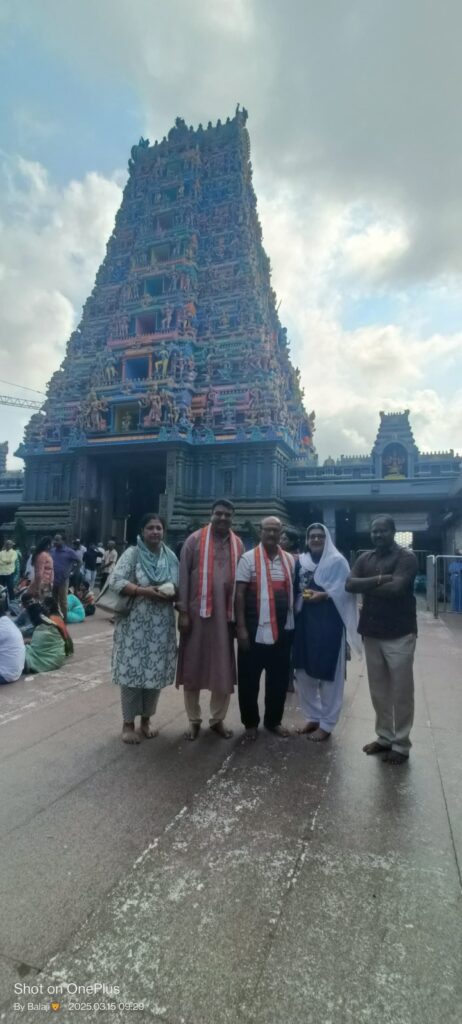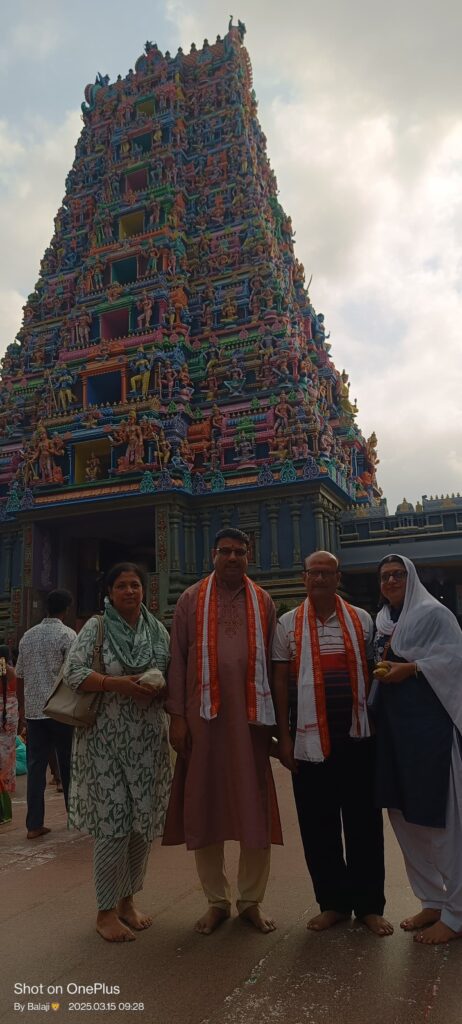A Divine Encounter: My Visit to the Lakshmi Narasimha Temple, Mangalagiri:
By Lokanath Mishra
On 16.3.25, Sunday , I had the privilege of visiting the revered Lakshmi Narasimha Temple, nestled at the foot of the Auspicious Hill in Mangalagiri, Andhra Pradesh along with my wife, her brother and her sister in law . This ancient Vaishnavite temple, one of the eight sacred places of Lord Vishnu in India, left an indelible mark on my heart.

As I approached the temple, I was struck by the imposing 153-foot tall gopuram, its eleven storeys soaring towards the sky. This magnificent structure, built by Vasireddy Venkatadri Nayudu, is one of the highest in South India and a testament to the region’s rich architectural heritage.
Upon entering the temple, I was enveloped in a sense of tranquility and devotion. The temple’s history, steeped in legend and mythology, is said to date back to the time of Yudhishthira, the eldest Pandava brother. The Brahma Vaivarta Purana, an ancient Hindu scripture, records the temple’s history, adding to its spiritual significance.

As I explored the temple complex, I was struck by the intricate carvings and sculptures that adorned the walls and pillars. The temple’s patronage by the Vijayanagara rulers, including Krishnadevaraya, is evident in the intricate architecture and inscriptions that dot the temple.
The temple’s presiding deity, Lord Narasimha, is revered as a symbol of divine protection and strength. As I stood before the deity, I felt a deep sense of connection and peace, as if the Lord’s benevolent gaze was upon me.

My visit to the Lakshmi Narasimha Temple, Mangalagiri, was a truly enriching experience. The temple’s sacred energy, steeped in history and mythology, left an indelible mark on my heart. I departed the temple with a sense of peace, tranquility, and a deeper connection to the divine.
The Ancient History of Mangalagiri: Unveiling the Legends and Patronage
Mangalagiri, a sacred town ,boasts a rich history that dates back to the era of the Pandavas. The Lakshmi Narasimha Temple, a prominent landmark in Mangalagiri, is deeply rooted in mythology and has been patronized by various dynasties throughout the centuries.
The Discovery by Yudhishthira
According to popular legend, the Lakshmi Narasimha Temple was discovered by Yudhishthira, the eldest Pandava brother. This ancient temple is said to have been hidden from the world, waiting for the righteous Yudhishthira to uncover its secrets.
The Brahma Vaivarta Purana
The temple’s history is intricately recorded in the Brahma Vaivarta Purana, one of the oldest Hindu religious scriptures. This sacred text provides valuable insights into the temple’s origins, mythology, and significance, highlighting its importance in Hindu mythology.
Patronage by the Vijayanagara Rulers
The Lakshmi Narasimha Temple received patronage from the Vijayanagara rulers, who played a significant role in shaping the temple’s architecture and history. One notable example is the visit of Krishnadevaraya, a prominent Vijayanagara emperor, who left an inscription at the temple site. This inscription serves as a testament to the temple’s historical significance and the emperor’s devotion to Lord Narasimha.
The Construction of the Gali Gopuram
The temple’s iconic eleven-story gali gopuram was constructed by Vasireddy Venkatadri Nayudu, a devoted zamindar and patron of the temple. This towering structure, built with precision and dedication, has become a defining feature of the temple and a symbol of Mangalagiri’s rich cultural heritage.
In conclusion, the history of Mangalagiri is a fascinating tapestry of mythology, patronage, and devotion. The Lakshmi Narasimha Temple, with its ancient origins and rich history, stands as a testament to the town’s significance in Hindu mythology and its enduring cultural legacy.

